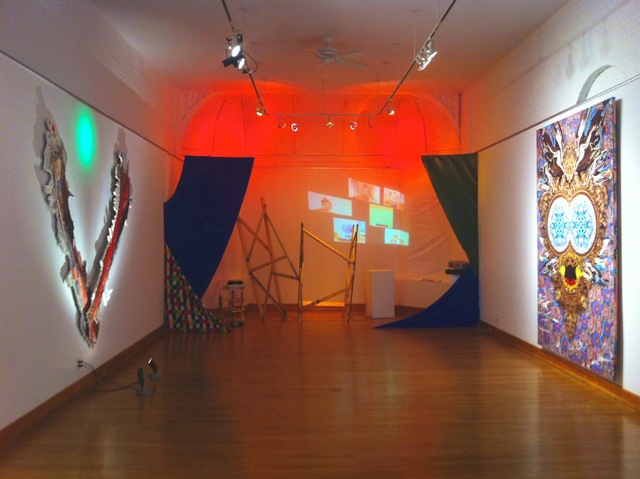
In 2010, addressing current changes in art and the world, Anna Harrah launched (re:)FORM Art—a curatorial project, dedicated to collaborating with up and coming artists whose work challenges the status quo. Bak’tun 13, a recent exhibition at Broome Street gallery, displayed diverse mediums and concepts inspired by the Mayan calendar and the discussions of the end-times prophecies while responding to a larger culture change within the art world. Anna believes that galleries have been shifting from extremely tailored gallery work—meant to be profitable—to something more experiential and collaborative, both for the artists and gallery attendees. Previously, (re:)FORM Art occupied the balcony space of a historic Lutheran church, intending to challenge ideas about religious spaces and secular spirituality in art. I spoke with Anna in the weeks following Hurricane Sandy about Bak’tun 13 and (re:)FORM Art.
—Haniya Rae for Guernica
Guernica: How did Bak’tun 13 as an art show come about?
Harrah: We have been curating one or two shows a year since 2010, yet haven’t done one since last December. Coincidentally, a gallery space I manage had available time for us to hold a pop up art show before its next exhibition. (re:)FORM art experiments with varied forms, hence the (re:) as in – regarding form. I’ve worked for galleries for a while now, and wanted to change the methods for presenting art. I felt that it was my responsibility to reignite the role of the curator and exhibition space, flipping it on its side to be inclusive rather than exclusive. A lot of traditional galleries have become mausoleums in a way.
Guernica: How did you find artists for Bak’tun 13?
Harrah: As an artist myself, I meet and speak to artists on a regular basis. From these conversations, a need for exposure emerges and common themes are discovered. I like to look at it (re:)FORM as a live social networking site, and draw upon the pool of artists within our combined social spheres. As it happens many of us share similar ideas about current art-making, but employ differing approaches, so that creates a unique mode for these exhibitions. My co-curator, Mike Berlant, suggested the title of Bak’tun 13, which evokes the Mayan apocalypse as a premise for reflecting on the change that is happening in art and the world at large. He proposed certain pieces and we both agreed that the artists complimented each other, but each piece also functioned individually, the whole becoming greater than the sum of its parts.
The power of a prophesy lies in the infectiousness of its ideas and the danger of apocalyptic thinking becoming self-fulfilling.
Guernica: Were you trying to move dialogue in any certain direction with Bak’tun 13?
Harrah: At first the theme of the show was open—there was a lot of conversation before trying to decide who goes into the show and why. Group shows are imperative right now—we should be reaching beyond the normal exhibition space and whatever institutions are already set up for artists. I’ll present an idea, in this case the “2012 phenomenon,” and then I’ll bring in artists that support the idea. The challenge is to combine the work in order to activate the space, while allowing each artist to stand on their own. Each artist has a strong individual voice, which is crucial. The most exciting part of this project is being able to make these voices sound well together. But I don’t want to put on a show that tries to pull works together into a narrow theme. What is more important is having a cohesive spirit within the show as opposed to an overly defined concept.
Guernica: You mention in your curatorial statement that there are these ideas of what the end of the world is supposed to be like, and that having these ideas becomes a self-fulfilling prophecy. In curating the show, how did the artists you chose convey that theme?
Harrah: Mike, who wrote the essay, was, I believe, implying that the power of a prophesy lies in the infectiousness of its ideas and the danger of apocalyptic thinking becoming self-fulfilling. It was an unfortunate coincidence that the biggest natural disaster this city has ever faced happened to hit on the Monday after the opening. So basically we opened and then were shut down by the hurricane. On the last day of the show power was back on in Lower Manhattan and we held a closing event, with performers and musicians that served as a sort of post-Sandy ritual.
In one way or another all the artists in the show deal with transformation and ending and talk about cultural symbols and alternate ways of perceiving time and change. We want people to leave the gallery and continue to think about what the work says and also what it represents. For example, Anna Rockwell had a popcorn maker resembling a Mayan relic. It’s interesting, as she takes corn itself and compares industrial agriculture versus natural seeds saved from many generations, posing the question of how we both exhaust and preserve history. Amy Mathis’ installation was a Beyonce video with a quasi-native dance performance. Mike Berlant’s painting reached beyond the boundaries of the traditional canvas frame and into the experiential by trying to redefine paint as a medium, basically choosing to sculpt the painted stroke. Jon Lee’s work was an idol cloaked in post-modern bling. In this way all of us are on this wheel on which the present, past and future are accessible all at once for us to draw from in our work.
Haniya Rae is Guernica’s assistant art editor. She graduated summa cum laude from the Maryland Institute College of Art where she studied Painting and Art History. Her work has been published in Art in America:Drawing and she was awarded a France-Merrick Fellowship for her work in community arts.

